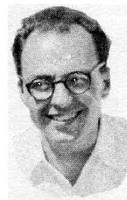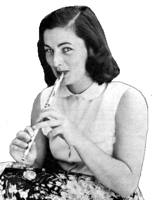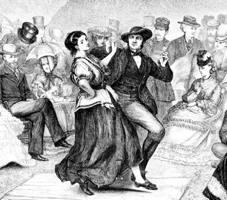
|
The Society of Folk Dance Historians (SFDH)
Irish Dance and Song
[
Home |
About |
Encyclopedia | CLICK AN IMAGE TO ENLARGE |


|
Cherished steps and tunes, preserved for centuries, come to the New World
 In the year 412 a lonely missionary brought home the first news of Christianity to a small island off the western coast of europe. To illustrate to the King and to the chieftains the mystery of the Holy Trinity in One God, he bent down and plucked from the green sod a sprig of a tiny plant with three leaves on one stem, and he handed it to the King. It was the first St. Patrick's Day, and the first green Shamrock to be honored by an Irishman.
In the year 412 a lonely missionary brought home the first news of Christianity to a small island off the western coast of europe. To illustrate to the King and to the chieftains the mystery of the Holy Trinity in One God, he bent down and plucked from the green sod a sprig of a tiny plant with three leaves on one stem, and he handed it to the King. It was the first St. Patrick's Day, and the first green Shamrock to be honored by an Irishman.
Fifteen hundred and twenty-three years later, in 1955, millions of people scattered over the earth, from Killarney to Kuala Lumpur and from Limerick to Lodi, will don green ties, throw back their chests, and proudly announce that "It's a great day for the Irish."
Music has flourished in Ireland since the dawn of history. There is evidence that as many as nine different musical instruments were in use in Ireland in the fifth century. Like many other ancient races, Ireland claims to have invented the harp, that, by the way, is a small harp, played upon the knee, with the musician seated. Other instruments were the corn-piopa, or hornpipe, that gave its name to one of our dances. There also was a stringed instrument called a fidil, a name now associated with a violin.
The country was governed by the chiefs of great families. Each had his own particular district under his jurisdiction. Some old-timers were the O'Neils of Tyrone, the O'Briens of Thomoni, the O'Rourkes of Breffny, and many others. When life was too quiet, a chief would raid the territory of his neighbors and carry off gold, cattle, or other valuables. The shortest declaration of war in history is said ot have been used on one of these occasions. O'Neill sent a message to his neighbor O'Donnell. It said, "Leave my territory–or–." O'Donnell sent back a message, "I will not leave your territory–and if–."
After the chief, the most important person in the kingdom was the Ollav or judge, who interpreted the law. After him came the the musician, and the bard or poet. In peace time he acted as chronicler of all events in the land and he recounted them to the court in long epic poems to the accompaniment of he harp. Many of these great poems have been handed down word-for-word to the present day, and much Irish history is retold in them.
In the ninth, tenth, and eleventh centuries, Ireland was invaded by the Danes and the Normans. Henry the Second, the Norman King of England, also made himself King of Ireland and from that day to the country has never had a day's peace. For the past seven hundred years the story is one of decline and destruction. The Golden Age of music, song, and dance was over. The great families were slowly wiped out or forced to leave the country. The musicians blamed for keeping alive the spark of national feeling, were forbidden under penalty of death to play their music. The end came with the departure of the last remnants of the old families for Europe at the end of the 17th century. They were called the "wild geese" and the musicians they left behind were all that was left of this most ancient of national cultures. These poets and musicians became wandering beggars and roamed the country, playing for dancing and singing, and in return, getting a meal and a bed for the night.
In spite of poverty and discouragement, this handful of men met at intervals of a year or two and exchanged music and ideas. The last great meeting of Irish bards was held in Belfast in 1792. By a fortunate stroke of fate there was at that meeting a young musician who realized that he was listening to music that was left only in the minds of a group of old men and he got to work and wrote down as many melodies as he could. He was Edward Bunting – the man who saved Ireland's music. Since then, many collections have been made. Approximately three thousand Irish melodies are in print – probably a tenth of what was once the national music.
At the beginning of the present century, a small group of men started to develop an interest in Irish language, dances, music, and everything that was truly Irish. The majority of the people of Ireland had succumbed to English influence and the Irish language was spoken only in a small area on the West Coast. This small group started an organization known as the Gaelic League, and from this group came the movement for independence that resulted in the Rising of Easter Week in 1916 and the formation of the Irish Republic as it is today.
Since the attainment of self government, Irish dancing and music have been widely encouraged. The dances most popular are those such as the figure dances, sixteen-hand reels, eight-hand jigs, and so forth. The three major divisions of the dances are Reels, Jigs, and Hornpipes. The Reels are danced to 4/4 (common-time) and are the fastest. The Jigs are danced in 6/8 time except for a few that are called Slip-jigs or Hop-jigs, and these are danced to a peculiar 9/8 time. The Hornpipes are all in 4/4 time and have a very characteristic repetition of the last note three times. At dances in Ireland, recordings are rarely used and there are few neighborhoods without a fiddler or a whistler or a musician of some sort.
Irish dancing must be taken easily. Let it come slowly and do not try to do too much at a time. Rarely in Ireland is the dancing done without a stop for a song or a solo dance or a tune on the fiddle. There is a tendency among beginners to play the music too fast and to try to dance too quickly. Irish group dances are not spectacular. They are meant to be danced for pure enjoyment by the dancer.
Those in Ireland who love and cherish the national dances and culture above all else have a great struggle on their hands. It is difficult for young people not to be swept off their feet by the top-hit tunes on the radio and television that invade the quietness of the Irish countryside. It is hard for an Irish father who has perhaps suffered for the freedom of his country to see his children lose interest in the national heritage of culture.
But what is this California doing? Having had for years a reputation for sophistication, it now gives every cross-roads fiddler and every step-dancer a clap on the back and says, "Please teach us to dance."
what a wonderful source of pride to us to write home and say that three hundred folk dance clubs in California would like to do an Irish dance. Do the folk dancers here realize what encouragement they give to the people in "the old country" when they practice a country's dances? Some of these days our people at home will tune in on the radio to California and their hearts will rise when they hear the Fallai Limnighe (Walls of Limerick) instead of "Poppa Loves Mambo."
DOCUMENTS
- British Isles, a region.
- Ireland, a country.
- Northern Ireland, a country.
- Una O'Farrell, an article.
From Let's Dance! magazine, March 1955.
This page © 2018 by Ron Houston.
Please do not copy any part of this page without including this copyright notice.
Please do not copy small portions out of context.
Please do not copy large portions without permission from Ron Houston.